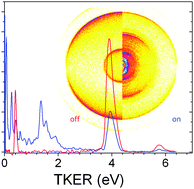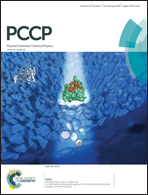Photodissociation of singlet oxygen in the UV region
Abstract
Photodissociation of singlet oxygen, O2 a1Δg, by ultraviolet radiation in the region from 200 to 240 nm has been investigated using velocity map imaging of the atomic oxygen photofragments. Singlet oxygen molecules are generated in a pulsed discharge and studied by one-laser photodissociation and detection around 226 nm as well as two color photodissociation at various wavelengths in the range from 200 to 240 nm. A simple model of the discharge on and off signal indicates efficient conversion of O2 X3Σg−(v = 0) in the parent beam to O2 a1Δg(v = 0–2). Minute amounts of highly excited vibrational levels of ground state O2 X3Σg−(v > 0) are detected but no evidence is found for production of the O2 b1Σg+ state. Over the decreasing wavelength range 240–200 nm the a1Δg-state signal relative to the X3Σg−(v = 0) signal decreases strongly. Around 226 nm the a1Δg(v = 0–2) states averaged branching ratio percentage for O(3Pjj = 2 : 1 : 0) is found to be 56 : 36 : 8 (±5%), respectively. The anisotropy parameter for photodissociation of a1Δg(v = 0–2) averages to β = 1.3 ± 0.4. The a1Δg(v = 0) photodissociation cross section is found to 3–10 times stronger than theory predicts. Furthermore, the photodissociation image shows a strong parallel character, (i.e., transition moment parallel to the molecular axis) while theory predicts a predominantly negative character.

- This article is part of the themed collection: Imaging molecular dynamics

 Please wait while we load your content...
Please wait while we load your content...